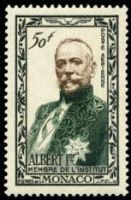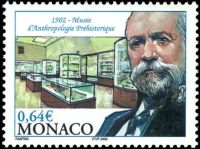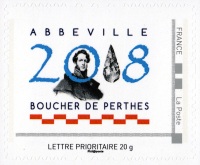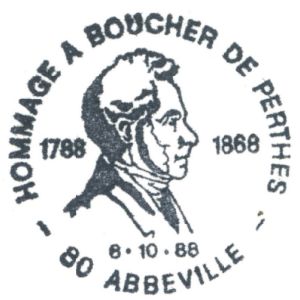the place where Paleontology and Paleoanthropology meets Philately
Contributors to Paleoanthropology science on stamps and other philatelic items
Scientists and other personalities who had a significant influence on the establishment of Paleoanthropology science, famous fossil collectors, museum founders, etc.
UNDER CONSTRUCTION
The personalities list:
Prince Albert I of Monaco
Jacques Boucher de Crèvecœur de Perthes
Prince Albert I of Monaco founder of Institute for Human Paleontology (IPH) in Paris.

 The first scientific establishment of this type in the world, the IPH, situated in Paris, came into being in 1910 under
the patronage of Prince Albert 1er, as a result of his meeting two of the most famous founders of contemporary prehistoric archaeology,
Professor Marcellin Boule and Abbe Henri Breuil.
The first scientific establishment of this type in the world, the IPH, situated in Paris, came into being in 1910 under
the patronage of Prince Albert 1er, as a result of his meeting two of the most famous founders of contemporary prehistoric archaeology,
Professor Marcellin Boule and Abbe Henri Breuil. Currently directed by Professor Henry de Lumley, the IPH takes on several missions: to manage extensive prehistoric excavation sites, to carry out field and laboratory research, to preserve a rich prehistoric heritage, to diffuse and develop scientific culture, to provide facilities for students and researchers. [R1]
Jacques Boucher de Crèvecœur de Perthes (10 September 1788 – 5 August 1868), sometimes referred to as Boucher de Perthes, was a French archaeologist and antiquary notable for his discovery, in about 1830, of flint tools in the gravels of the Somme valley.

 About the year 1830 he had found, in the gravels of the Somme valley, flints which in his opinion
bore evidence of human handiwork.
About the year 1830 he had found, in the gravels of the Somme valley, flints which in his opinion
bore evidence of human handiwork. In 1847 he commenced the issue of his monumental three volume work, Antiquités celtiques et antédiluviennes, a work in which he was the first to establish the existence of man in the Pleistocene or early Quaternary period.
Although Boucher de Perthes was the first to establish that Europe had been populated by early man, he was not able to pinpoint the precise period, because the scientific frame of reference did not then exist. [R2]
References:
- [R1] Prince Albert I of Monaco: Wikipedia.
- [R2] Jacques Boucher de Crèvecœur de Perthes: Wikipedia, Boucher-de-Perthes Museum,